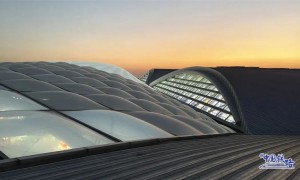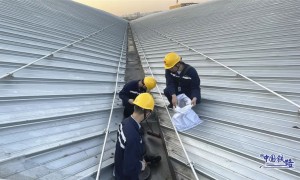国务院办公厅关于大力发展装配式建筑的指导意见:
(五)创新装配式建筑设计。统筹建筑结构、机电设备、部品部件、装配施工、装饰装修,推行装配式建筑一体化集成设计。推广通用化、模数化、标准化设计方式,积极应用建筑信息模型技术,提高建筑领域各专业协同设计能力,加强对装配式建筑建设全过程的指导和服务。鼓励设计单位与科研院所、高校等联合开发装配式建筑设计技术和通用设计软件。
这里的模数化如何理解?是指100mm基本模数协调尺寸?
建议看一下这篇文章
以下内容来源与archdaily,是一个印尼巴丹岛的社区设计
Expandable House / Urban Rural Systems
-
Architects
Urban Rural Systems
-
Location
Batam, Indonesia
-
Architect in Charge
Stephen Cairns
-
Design Team
Miya Irawati, Chen Ting, Azwan Aziz, Dio Guna Putra, Sumiadi Rahman
-
Collaborators
: Alwi (community leader), Batam Municipal Planning Authority (BAPPEDA), Rahmat Kurniawan
-
Consultants
Engineer (Batam), Teddy Tambuan; Engineer (Singapore), Johannes Müller; Foundations Contractor (A Square Engineering)
-
Budget
USD 25,000
-
Area
36.0 m2
-
Project Year
2018
-
Photographs
Dio Guna Putra
-
Manufacturers
Hebel, Fibreglass
Text description provided by the architects.
The expandable house (‘rumah tambah’ in Bahasa Indonesia, or rubah for short) is designed to be one part of a sustainable response to the challenges of rapidly developing cities like Batam, in Indonesia’s Riau Archipelago. Once a collection of sleepy fishing villages of a few thousand inhabitants,Batam developed to be a cosmopolitan city of over one million people in less than 40 years. This remarkable growth, fueled by a new free trade agreement and Batam’s proximity to Singapore, has not abated. Young migrants from all over Indonesia moved there to seek their fortune.
巴丹在过去四十年,从一个人口只有几千人的渔村,发展为超百万人口的城市
By 2015 Batam was named the fastest growing city in the world. As a consequence, the city was confronted by major planning problems: How to accommodate the influx of migrants?
这种发展带来一个问题:如何容纳这些新移民
How to provide sufficient housing, and appropriate water and sewage systems?
如何提供足够的住房、淡水,以及污水处理
How to fund adequate transport infrastructure, and provide schools, universities and hospitals?
基础设置、学校、医院……
The expandable house project focuses on the challenge of housing. It does so by allowing the building to be flexibly configured around the fluctuating patterns of resource consumption and expenditure, or metabolism, of its residents.
本项目主要关注住房挑战
Practically this means understanding the patterns of household income generation and expenditure, water, energy and food consumption, as well as waste production. As this metabolism is usually uneven and often precarious, it is important that the architecture can be a dwelling and income generating unit, that manages its own waste, water and energy locally.
实际上,这意味着要了解家庭收入和支出、水、能源和食品消费的模式,以及废物生产。由于这种新陈代谢通常是不平衡的,而且经常是不稳定的,所以建筑可以是一个居住和收入产生的单位,在当地管理自己的废物、水和能源是很重要的。
The expandable house is designed around the following five principles:
本项目围绕以下五点设计
1.Sandwich Section. The house provides a roof that can be hoisted, and floor and foundations (the bread) that can support up to three additional floors (the filling). This system allows flexible financing whereby the developer or state housing agency provides the roof and foundations, while the residents provide infill as their circumstances require and budget allows. It also helps accommodate crucial income generating functions (shop, café, garage, cottage industry) along with dwelling.
可以举起屋顶,从而增加2-3层
2. Domestic Density. The house encourages domestic densification in the vertical dimension. This supports the benefits of co-location of dwellings and employment. It also helps to reduce the settlement footprint on arable land, and the demand for expensive infrastructures (roads, electrical and potable water networks).
大容积率,工作和住宿近,基础设施也会节省
3. Decentralized Systems. Rainwater harvesting and solar electricity generating technologies, sewage and septic tank systems, and passive cooling principles are integrated locally with the expandable house, avoiding expensive and often unreliable centralized, or ‘big pipe’, approaches to infrastructure provision.
房子里的功能模块是分离的?没太看懂
4. Productive Landscapes. The expandable house integrates food and building material production capacity locally. This is achieved by integrating bamboo plantations and kitchen gardens into the planning logic of the house, and helps further diversify the resource base of the expandable house.
应该是兼顾多种功能,可以改成小吃店
5.Seed Package. The expandable house is designed as a seed package, containing technologies, material strategies and planning guidelines that can develop in different ways depending on local social, cultural and environmental conditions. We intend that diverse tropical towns will grow from the common seed package.
具有自我成长的属性







